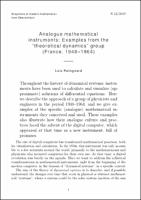| dc.contributor.author | Petitgirard, Loïc | |
| dc.contributor.editor | Randecker, Anja | |
| dc.contributor.editor | Munday, Sara | |
| dc.contributor.editor | Jahns, Sophia | |
| dc.date.accessioned | 2019-11-21T12:51:26Z | |
| dc.date.available | 2019-11-21T12:51:26Z | |
| dc.date.issued | 2019-11-21 | |
| dc.identifier.uri | http://publications.mfo.de/handle/mfo/3684 | |
| dc.description.abstract | Throughout the history of dynamical systems, instruments
have been used to calculate and visualize (approximate)
solutions of differential equations. Here
we describe the approach of a group of physicists and
engineers in the period 1948–1964, and we give examples
of the specific (analogue) mathematical instruments
they conceived and used. These examples
also illustrate how their analogue culture and practices
faced the advent of the digital computer, which
appeared at that time as a new instrument, full of
promises. | en_US |
| dc.language.iso | en | en_US |
| dc.publisher | Mathematisches Forschungsinstitut Oberwolfach | en_US |
| dc.relation.ispartofseries | Snapshots of modern mathematics from Oberwolfach;2019,12 | |
| dc.rights | Attribution-ShareAlike 4.0 International | * |
| dc.rights.uri | http://creativecommons.org/licenses/by-sa/4.0/ | * |
| dc.title | Analogue mathematical instruments: Examples from the “theoretical dynamics” group (France, 1948–1964) | en_US |
| dc.type | Article | en_US |
| dc.identifier.doi | 10.14760/SNAP-2019-012-EN | |
| local.series.id | SNAP-2019-012-EN | en_US |
| local.subject.snapshot | Analysis | en_US |
| local.subject.snapshot | Numerics and Scientific Computing | en_US |
| dc.identifier.urn | urn:nbn:de:101:1-2019112812070680963649 | |
| dc.identifier.ppn | 1683711122 | |


